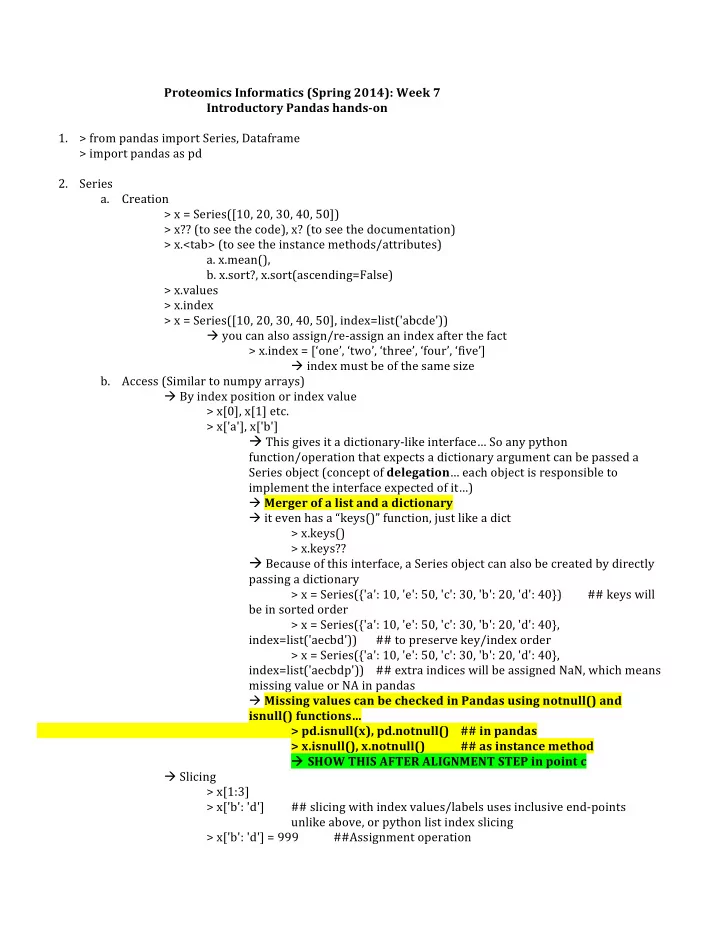

Proteomics ¡Informatics ¡(Spring ¡2014): ¡Week ¡7 ¡ Introductory ¡Pandas ¡hands-‑on ¡ ¡ 1. > ¡from ¡pandas ¡import ¡Series, ¡Dataframe ¡ > ¡import ¡pandas ¡as ¡pd ¡ ¡ 2. Series ¡ a. Creation ¡ > ¡x ¡= ¡Series([10, ¡20, ¡30, ¡40, ¡50]) ¡ > ¡x?? ¡(to ¡see ¡the ¡code), ¡x? ¡(to ¡see ¡the ¡documentation) ¡ > ¡x.<tab> ¡(to ¡see ¡the ¡instance ¡methods/attributes) ¡ a. ¡x.mean(), ¡ ¡ b. ¡x.sort?, ¡x.sort(ascending=False) ¡ > ¡x.values ¡ > ¡x.index ¡ > ¡x ¡= ¡Series([10, ¡20, ¡30, ¡40, ¡50], ¡index=list('abcde')) ¡ ¡ à ¡you ¡can ¡also ¡assign/re-‑assign ¡an ¡index ¡after ¡the ¡fact ¡ ¡ ¡ > ¡x.index ¡= ¡[‘one’, ¡‘two’, ¡‘three’, ¡‘four’, ¡‘five’] ¡ ¡ ¡ à ¡index ¡must ¡be ¡of ¡the ¡same ¡size ¡ b. Access ¡(Similar ¡to ¡numpy ¡arrays) ¡ à ¡By ¡index ¡position ¡or ¡index ¡value ¡ ¡ > ¡x[0], ¡x[1] ¡etc. ¡ ¡ > ¡x['a'], ¡x['b'] ¡ à ¡This ¡gives ¡it ¡a ¡dictionary-‑like ¡interface… ¡So ¡any ¡python ¡ function/operation ¡that ¡expects ¡a ¡dictionary ¡argument ¡can ¡be ¡passed ¡a ¡ Series ¡object ¡(concept ¡of ¡ delegation … ¡each ¡object ¡is ¡responsible ¡to ¡ implement ¡the ¡interface ¡expected ¡of ¡it…) ¡ à ¡ Merger ¡of ¡a ¡list ¡and ¡a ¡dictionary ¡ ¡ à ¡it ¡even ¡has ¡a ¡“keys()” ¡function, ¡just ¡like ¡a ¡dict ¡ ¡ ¡ ¡ > ¡x.keys() ¡ ¡ ¡ > ¡x.keys?? ¡ à ¡Because ¡of ¡this ¡interface, ¡a ¡Series ¡object ¡can ¡also ¡be ¡created ¡by ¡directly ¡ passing ¡a ¡dictionary ¡ ¡ > ¡x ¡= ¡Series({'a': ¡10, ¡'e': ¡50, ¡'c': ¡30, ¡'b': ¡20, ¡'d': ¡40}) ¡ ## ¡keys ¡will ¡ be ¡in ¡sorted ¡order ¡ > ¡x ¡= ¡Series({'a': ¡10, ¡'e': ¡50, ¡'c': ¡30, ¡'b': ¡20, ¡'d': ¡40}, ¡ index=list('aecbd')) ¡ ## ¡to ¡preserve ¡key/index ¡order ¡ > ¡x ¡= ¡Series({'a': ¡10, ¡'e': ¡50, ¡'c': ¡30, ¡'b': ¡20, ¡'d': ¡40}, ¡ index=list('aecbdp')) ¡ ## ¡extra ¡indices ¡will ¡be ¡assigned ¡NaN, ¡which ¡means ¡ missing ¡value ¡or ¡NA ¡in ¡pandas ¡ à ¡ Missing ¡values ¡can ¡be ¡checked ¡in ¡Pandas ¡using ¡notnull() ¡and ¡ isnull() ¡functions… ¡ ¡ ¡ ¡ ¡ ¡ ¡ ¡ > ¡pd.isnull(x), ¡pd.notnull() ¡ ## ¡in ¡pandas ¡ > ¡x.isnull(), ¡x.notnull() ¡ ## ¡as ¡instance ¡method ¡ à ¡SHOW ¡THIS ¡AFTER ¡ALIGNMENT ¡STEP ¡in ¡point ¡c ¡ à à ¡Slicing ¡ ¡ > ¡x[1:3] ¡ > ¡x['b': ¡'d'] ¡ ## ¡slicing ¡with ¡index ¡values/labels ¡uses ¡inclusive ¡end-‑points ¡ unlike ¡above, ¡or ¡python ¡list ¡index ¡slicing ¡ > ¡x['b': ¡'d'] ¡= ¡999 ¡ ¡ ##Assignment ¡operation ¡
¡ ¡ ¡ à ¡Boolean ¡indexing: ¡ ¡ ¡ ¡ ¡ > ¡x ¡>= ¡30 ¡ ¡ ¡ ¡ ¡ > ¡x[x>=30] ¡ ## ¡ Note ¡that ¡during ¡all ¡these ¡operations, ¡indices ¡are ¡preserved ¡ ¡ c. One ¡major ¡utility ¡of ¡having ¡the ¡index ¡objects ¡is ¡automatic ¡alignment ¡across ¡different ¡Series ¡or ¡ Dataframe ¡objects ¡ > ¡x ¡= ¡Series({'a': ¡10, ¡'b': ¡20, ¡'c': ¡30, ¡'d': ¡40, ¡'e': ¡50}) ¡ > ¡y ¡= ¡Series({'a': ¡10, ¡'b’: ¡100}) ¡ > ¡x+y ¡ ## ¡well ¡defined ¡ ¡ ## ¡More ¡on ¡data ¡alignment ¡later ¡ ¡ ¡ à ¡Index ¡labels ¡can ¡also ¡be ¡used ¡to ¡drop ¡specific ¡entries ¡from ¡the ¡Series ¡object ¡ ¡ ¡ ¡ > ¡x.drop('a') ¡ ## ¡returns ¡a ¡new ¡Series ¡object ¡with ¡dropped ¡entry ¡ ¡ 3. Dataframe ¡ ¡ a. Creation ¡( numerous ¡ways… ¡Like ¡a ¡list ¡of ¡lists… ¡But ¡not ¡required ¡to ¡discuss… ¡since ¡mostly ¡ we’ll ¡be ¡building ¡these ¡directly ¡from ¡files… ¡for ¡now, ¡go ¡with ¡this ¡view!! ): ¡ > ¡data ¡= ¡{'a': ¡range(1,11),'b': ¡range(21,31),'c': ¡range(31,41)} ¡ ## ¡From ¡dict ¡of ¡equal-‑length ¡ lists ¡ > ¡dataF ¡= ¡DataFrame(data) ¡ ¡ à ¡has ¡both ¡row ¡and ¡column ¡indexes ¡ ¡ à ¡(row)index ¡automatically ¡populated ¡(can ¡be ¡explicitly ¡provided ¡as ¡additional ¡ argument ¡to ¡DataFrame); ¡columns ¡are ¡placed ¡in ¡sorted ¡order ¡(can ¡be ¡altered ¡by ¡explicitly ¡ providing ¡columns ¡as ¡argument) ¡ ¡ ¡ > ¡dataF ¡= ¡DataFrame(data, ¡index=list('pqrstuvwxy'), ¡columns=list('cba')) ¡ ¡ ¡ > ¡dataF.index ¡= ¡list('pqrstuvwxy') ¡ ## ¡providing ¡the ¡index ¡after ¡the ¡fact ¡ ¡ ¡ ¡ > ¡dataF.values ¡( List ¡of ¡lists ¡representation) , ¡dataF.columns, ¡dataF.index ¡ ¡ b. Access ¡ i. Individual ¡columns ¡as ¡Series ¡objects ¡ > ¡dataF['a'] ¡ ## ¡dict-‑like ¡notation ¡ > ¡dataF.a ¡ ## ¡object ¡attribute ¡dot-‑notation ¡ à ¡The ¡series ¡will ¡have ¡the ¡same ¡index ¡as ¡the ¡parent ¡dataframe ¡ ii. Multiple ¡columns ¡(as ¡a ¡dataframe) ¡ > ¡dataF[['a', ¡'b']] ¡ ## ¡use ¡list ¡of ¡column ¡indices ¡ iii. Special ¡cases ¡(Apply ¡a ¡filter ¡on ¡rows ¡and/or ¡values): ¡ ¡ > ¡dataF[:2] ¡ ## ¡Select ¡the ¡first ¡2 ¡rows ¡(slicing) ¡ > ¡dataF[dataF.a ¡> ¡5] ¡ ## ¡Boolean ¡indexing ¡on ¡specific ¡rows ¡ > ¡dataF[dataF ¡> ¡25] ¡ ## ¡Boolean ¡indexing ¡on ¡the ¡whole ¡dataFrame ¡ iv. Indexing ¡on ¡the ¡rows: ¡ à ¡<DataFrame>. ix ¡field… ¡For ¡ex. ¡ > ¡dataF.ix[2] ¡or ¡dataF.ix['r'] ¡ à ¡Slicing ¡ ¡ > ¡dataF.ix[2:5] ¡or ¡dataF.ix['r': ¡'t'] ¡ à ¡Selecting ¡rows ¡and ¡columns: ¡ > ¡dataF.ix[['p', ¡'q', ¡'r'], ¡['a', ¡'b']] ¡ > ¡dataF.ix[2:5, ¡['a', ¡'b']] ¡ > ¡dataF.ix[:, ¡['a', ¡'b']] ¡ ## ¡all ¡rows ¡and ¡2 ¡columns ¡ > ¡dataF.ix[dataF.a>5, ¡:2] ¡ ¡
Recommend
More recommend